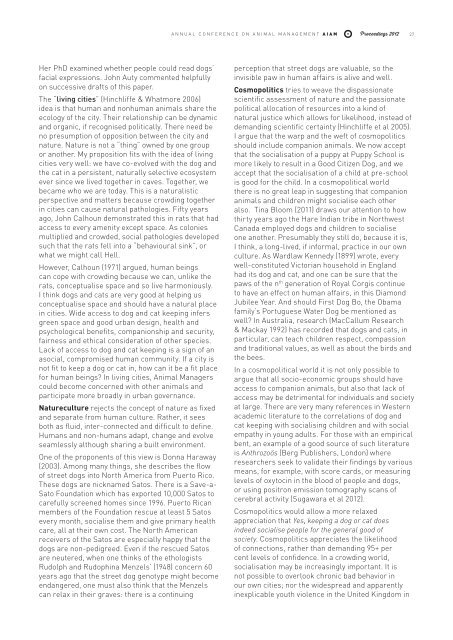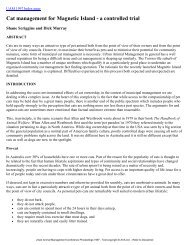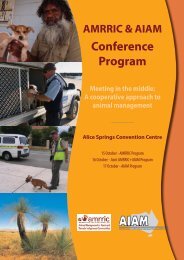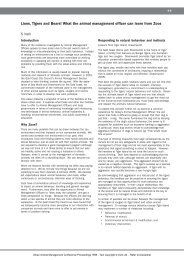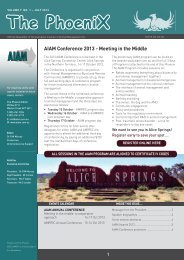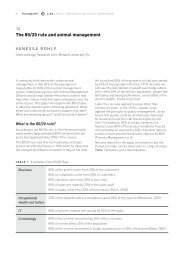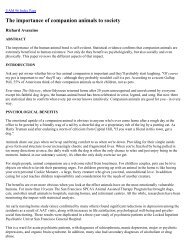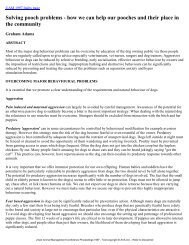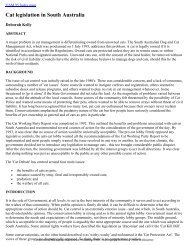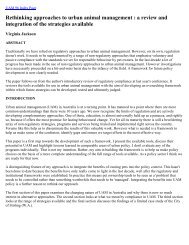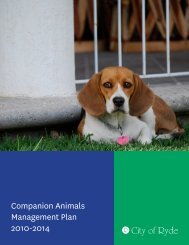Proceedings OF ThE - Australian Institute of Animal Management Inc
Proceedings OF ThE - Australian Institute of Animal Management Inc
Proceedings OF ThE - Australian Institute of Animal Management Inc
Create successful ePaper yourself
Turn your PDF publications into a flip-book with our unique Google optimized e-Paper software.
Annual Conference on <strong>Animal</strong> <strong>Management</strong> AIAM <strong>Proceedings</strong> 2012 27<br />
Her PhD examined whether people could read dogs’<br />
facial expressions. John Auty commented helpfully<br />
on successive drafts <strong>of</strong> this paper.<br />
The “living cities” (Hinchliffe & Whatmore 2006)<br />
idea is that human and nonhuman animals share the<br />
ecology <strong>of</strong> the city. Their relationship can be dynamic<br />
and organic, if recognised politically. There need be<br />
no presumption <strong>of</strong> opposition between the city and<br />
nature. Nature is not a “thing” owned by one group<br />
or another. My proposition fits with the idea <strong>of</strong> living<br />
cities very well: we have co-evolved with the dog and<br />
the cat in a persistent, naturally selective ecosystem<br />
ever since we lived together in caves. Together, we<br />
became who we are today. This is a naturalistic<br />
perspective and matters because crowding together<br />
in cities can cause natural pathologies. Fifty years<br />
ago, John Calhoun demonstrated this in rats that had<br />
access to every amenity except space. As colonies<br />
multiplied and crowded, social pathologies developed<br />
such that the rats fell into a “behavioural sink”, or<br />
what we might call Hell.<br />
However, Calhoun (1971) argued, human beings<br />
can cope with crowding because we can, unlike the<br />
rats, conceptualise space and so live harmoniously.<br />
I think dogs and cats are very good at helping us<br />
conceptualise space and should have a natural place<br />
in cities. Wide access to dog and cat keeping infers<br />
green space and good urban design, health and<br />
psychological benefits, companionship and security,<br />
fairness and ethical consideration <strong>of</strong> other species.<br />
Lack <strong>of</strong> access to dog and cat keeping is a sign <strong>of</strong> an<br />
asocial, compromised human community. If a city is<br />
not fit to keep a dog or cat in, how can it be a fit place<br />
for human beings? In living cities, <strong>Animal</strong> Managers<br />
could become concerned with other animals and<br />
participate more broadly in urban governance.<br />
Natureculture rejects the concept <strong>of</strong> nature as fixed<br />
and separate from human culture. Rather, it sees<br />
both as fluid, inter-connected and difficult to define.<br />
Humans and non-humans adapt, change and evolve<br />
seamlessly although sharing a built environment.<br />
One <strong>of</strong> the proponents <strong>of</strong> this view is Donna Haraway<br />
(2003). Among many things, she describes the flow<br />
<strong>of</strong> street dogs into North America from Puerto Rico.<br />
These dogs are nicknamed Satos. There is a Save-a-<br />
Sato Foundation which has exported 10,000 Satos to<br />
carefully screened homes since 1996. Puerto Rican<br />
members <strong>of</strong> the Foundation rescue at least 5 Satos<br />
every month, socialise them and give primary health<br />
care, all at their own cost. The North American<br />
receivers <strong>of</strong> the Satos are especially happy that the<br />
dogs are non-pedigreed. Even if the rescued Satos<br />
are neutered, when one thinks <strong>of</strong> the ethologists<br />
Rudolph and Rudophina Menzels’ (1948) concern 60<br />
years ago that the street dog genotype might become<br />
endangered, one must also think that the Menzels<br />
can relax in their graves: there is a continuing<br />
perception that street dogs are valuable, so the<br />
invisible paw in human affairs is alive and well.<br />
Cosmopolitics tries to weave the dispassionate<br />
scientific assessment <strong>of</strong> nature and the passionate<br />
political allocation <strong>of</strong> resources into a kind <strong>of</strong><br />
natural justice which allows for likelihood, instead <strong>of</strong><br />
demanding scientific certainty (Hinchliffe et al 2005).<br />
I argue that the warp and the weft <strong>of</strong> cosmopolitics<br />
should include companion animals. We now accept<br />
that the socialisation <strong>of</strong> a puppy at Puppy School is<br />
more likely to result in a Good Citizen Dog, and we<br />
accept that the socialisation <strong>of</strong> a child at pre-school<br />
is good for the child. In a cosmopolitical world<br />
there is no great leap in suggesting that companion<br />
animals and children might socialise each other<br />
also. Tina Bloom (2011) draws our attention to how<br />
thirty years ago the Hare Indian tribe in Northwest<br />
Canada employed dogs and children to socialise<br />
one another. Presumably they still do, because it is,<br />
I think, a long-lived, if informal, practice in our own<br />
culture. As Wardlaw Kennedy (1899) wrote, every<br />
well-constituted Victorian household in England<br />
had its dog and cat, and one can be sure that the<br />
paws <strong>of</strong> the n th generation <strong>of</strong> Royal Corgis continue<br />
to have an effect on human affairs, in this Diamond<br />
Jubilee Year. And should First Dog Bo, the Obama<br />
family’s Portuguese Water Dog be mentioned as<br />
well? In Australia, research (MacCallum Research<br />
& Mackay 1992) has recorded that dogs and cats, in<br />
particular, can teach children respect, compassion<br />
and traditional values, as well as about the birds and<br />
the bees.<br />
In a cosmopolitical world it is not only possible to<br />
argue that all socio-economic groups should have<br />
access to companion animals, but also that lack <strong>of</strong><br />
access may be detrimental for individuals and society<br />
at large. There are very many references in Western<br />
academic literature to the correlations <strong>of</strong> dog and<br />
cat keeping with socialising children and with social<br />
empathy in young adults. For those with an empirical<br />
bent, an example <strong>of</strong> a good source <strong>of</strong> such literature<br />
is Anthrozoös (Berg Publishers, London) where<br />
researchers seek to validate their findings by various<br />
means, for example, with score cards, or measuring<br />
levels <strong>of</strong> oxytocin in the blood <strong>of</strong> people and dogs,<br />
or using positron emission tomography scans <strong>of</strong><br />
cerebral activity (Sugawara et al 2012).<br />
Cosmopolitics would allow a more relaxed<br />
appreciation that Yes, keeping a dog or cat does<br />
indeed socialise people for the general good <strong>of</strong><br />
society. Cosmopolitics appreciates the likelihood<br />
<strong>of</strong> connections, rather than demanding 95+ per<br />
cent levels <strong>of</strong> confidence. In a crowding world,<br />
socialisation may be increasingly important. It is<br />
not possible to overlook chronic bad behavior in<br />
our own cities; nor the widespread and apparently<br />
inexplicable youth violence in the United Kingdom in


